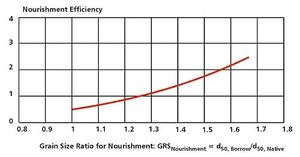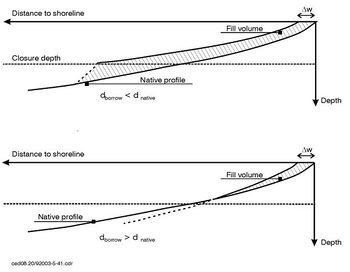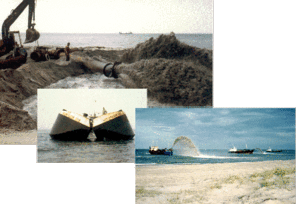Shore nourishment
Nourishment can be divided into backshore nourishment, beach nourishment and shoreface nourishment.
Contents
What is nourishment?
Nourishment can be regarded as a very natural way of combating coastal erosion and shore erosion as it artificially replaces a deficit in the sediment budget over a certain stretch with a corresponding volume of sand. However, as the cause of the erosion is not eliminated, erosion will continue in the nourished sand. It is thus inherent in the nourishment concept that the nourished sand is gradually sacrificed. This means that nourishment as a stand-alone method normally requires a long-term maintenance effort. In general, nourishment is only suited for major sections of shoreline; otherwise the loss of sand to neighbouring sections will be too large. Regular nourishment requires a permanent well-functioning organisation, which makes nourishment as a stand-alone solution unsuitable for privately owned coastlines.
The success of a nourishment scheme depends very much on the grain size of the nourished sand, the so-called borrow material, relative to the grain size of the native sand. As described in Onshore and Offshore Transport and Equilibrium Coastal Profile, the characteristics of the sand determine the overall shape of the coastal profile expressed in the equilibrium profile concept. Furthermore, in nature the hydrodynamic processes tend to sort the sediments in the profile so that the grain size decreases with increasing water depth.
Equilibrium conditions
When borrow sand is placed in a coastal profile, neither the profile nor the grain size distribution will match the equilibrium conditions. Nature will attempt to re-establish a new equilibrium profile so changes will always occur in the nourished profile. There will also be changes caused by the continued long-term erosion trend and the profile response to individual events. This means that in practice it is neither possible to perform a short-term nor a long-term stable nourishment at an eroding coast. It is inherently unstable on eroding shorelines. These are the basic realities, which the public, the politicians and those who fund the projects, find it hard to accept. On the other hand, as environmental concerns and requirements for sustainability are gaining in importance, nourishment has gradually increased its share of shoreline management schemes over the last decades.
Grain size

If the borrow sand is finer than the native sand, it will tend to form a flatter profile than the natural one. The equilibrium reshaping of the nourished sand will reach out to the closure depth. If the objective of the nourishment is to obtain a wider beach, this will require very large volumes of sand, as illustrated in the upper part of Fig. 1.
It is evident that the volume of sand needed to obtain a certain beach width increases drastically with the decreasing grain size of the nourished sand. Most coastal authorities realise this and some of them have introduced special bonuses for their nourishment contractors when they provide coarse sand.
It is evident from this figure that if borrow sand with a larger grain size than that of the native sand is nourished into a coastal profile, it will tend to form a steeper profile than the natural profile. This means that a wider beach will tend to be formed, see the lower part Fig. 1.
Furthermore, coarser sand will be more stable in terms of longshore loss. This nourishment efficiency of the nourished sand has been studied by the Danish Coastal Authority on basis of many years of nourishment along the Danish North Sea Coast[1]. The nourishment efficiency is defined as the ratio between the erosion rate for the natural sand (theoretical) and that of the nourished sand. The nourishment efficiency has been analysed as function of the ratio between the mean grain size of the borrow sand and that of the native sand:
- [math]GSR_{Nourishment}=d_{50,Borrow}/d_{50,Native}[/math]
The analysis covers effects of cross shore as well as longshore effects. The results are expressed as a relation between the nourishment efficiency versus the grain size ratio [math]GSR_{Nourishment}[/math]. It is evident from the relation shown in Fig. 2. that the Nourishment Efficiency increases considerably with increasing Grain Size Ratio for Nourishment.
Steepness of profile
Areas, which for a long time have been protected by hard coastal protection structures, have often developed steepened coastal profiles. Such areas are very far from their cross-shore equilibrium form. If nourishment is introduced in such areas it will require huge volumes of sand to restore the profile to the equilibrium profile, which is required to release the pressure on the coastal structures. In such cases, it is very important to find borrow sand, which is coarser than the native sand.
Methods, functional characteristics and applicability
The three different nourishment methods will be discussed briefly in the following.
Backshore nourishment
Backshore nourishment is the strengthening of the upper part of the beach by placing nourishment on the backshore or at the foot of the dunes. The main objective of backshore nourishment is to strengthen the backshore/dune against erosion and breaching during extreme events. The material is stockpiled in front of the dunes and acts as a buffer, which is sacrificed during extreme events. This kind of nourishment works more by volume than by trying to restore the natural wide beach. The loss is normally large during extreme events, whereby steep scarps are formed. Backshore nourishment can be characterised as a kind of emergency measure against dune setback/breach; it cannot, therefore, be characterised as a sustainable way of performing nourishment and it does not normally look very natural.
Backshore nourishment can be performed by hydraulic pumping sand through pipes discharging at the foot of the dunes and later adjusted using a bulldozer. The sand source can be either an offshore supply via a cross-profile pipeline, floating or buried, or it can be supplied along the shore from, for example, a sand bypassing plant. The sand can also be supplied via land transport by dumpers.
Beach nourishment
Beach nourishment is the supply of sand to the shore to increase the recreational value and/or to secure the beach against shore erosion by feeding sand on the beach. It is not a coastal protection measure, as the beach will normally be flooded during extreme events, but it will support possible coastal protection measures. When performing beach nourishment, the borrow sand must be similar to the native sand to adjust smoothly to the natural profile. It may be an advantage to use slightly coarser sand than the natural beach sand, as this will enhance the stability of the resulting slightly steeper profile. Finer sand will very quickly be transferred to deeper water and will thus not contribute directly to a wider beach. However, the fine sand will help building up the outer part of the profile. See also experiences with beach nourishments in Portugal.
Shoreface nourishment
Shoreface nourishment is the supply of sand to the outer part of the coastal profile, typically on the seaside of the bar. It will strengthen the coastal profile and add sediment to the littoral budget in general. This type of nourishment is used in areas where coastal protection measures have steepened the coastal profile or in areas with a long-term sediment deficit. Shoreface nourishment is sometimes used with beach nourishment in order to strengthen the entire coastal profile. It is recommended for obtaining a nourished profile close to the equilibrium profile. Stand-alone shoreface nourishment acts only indirectly as a shore protection measure through slightly decreased wave exposure and as a shore restoration measure with considerable delay and little efficiency.
Shoreface nourishment is often performed using split barges. The unloading is fast and the unit price therefore low. Shoreface nourishment can profitably be used in connection with large beach nourishment schemes, in which borrow material, which does not fulfil the requirements for beach nourishment, can be used in the outer part of the profile where it naturally belongs.
Beach Scraping
Method
A beach berm consisting of coarse sand or gravel is sometimes formed during relatively mild summer wave conditions, which tend to transport seabed material towards the beach. Beach scraping is normally performed using front loaders.
Functional characteristics
The purpose of beach scraping is to strengthen the upper part of the beach profile and the foot of the cliff. The material is placed in a position that reduces the erosion occurring during storm surge conditions.
Applicability
This method can be used for beaches, which are mainly exposed to seasonal erosion, whereas it is probably not feasible for locations, which are exposed to long-term erosion. One disadvantage of the method is that the material used for strengthening the upper part of the beach profile is taken from the lower part of the same profile, which means that the method only contributes insignificantly to the overall stability of the beach profile. Another issue is that equipment operated during late summer may disturb recreational activities.
See also
- Dealing with coastal erosion
- Experiences with beach nourishments in Portugal
- Artificial nourishment
- Beach nourishment
References
Further reading
- Mangor, K., Drønen, N. K., Kaergaard, K.H. and Kristensen, N.E. 2017. Shoreline management guidelines. DHI https://www.dhigroup.com/marine-water/ebook-shoreline-management-guidelines
Please note that others may also have edited the contents of this article.
|


